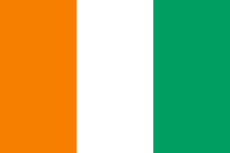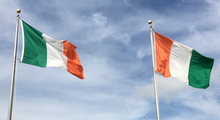Flag of Ivory Coast
The flag of Ivory Coast (French: drapeau de la Côte d'Ivoire, lit. 'flag of the Coast of Ivory') features three equal vertical bands of orange (hoist side), white, and green. It is also the national emblem of the Republic of Ivory Coast. Its status as a national emblem affirms to Article 29 of the Constitution of Ivory Coast. The flag has the proportions of 3:2 and consists of three vertical bands of equal width.
 | |
| Use | National flag and ensign |
|---|---|
| Proportion | 2:3 |
| Adopted | 3 December 1959 |
| Design | A vertical tricolor of orange, white, and green. |

Design and symbolism
In 1959, when the Ivorian Legislative Assembly was adopting the flag, Minister of State Jean Delafosse said:[1]
The National Emblem must be the living symbol of the fatherland:
- orange: recalling the color of our rich and generous earth; it is the meaning of our struggle, the blood of a young people in its struggle for our emancipation;
- white: peace, but the peace of right;
- green: hope, of course, for others; but for us, the certainty of a better future
In 1960, when the Legislative Assembly was drafting the constitution, Mamadou Coulibaly said:[2]
the Orange stripe expresses the splendour of national blossoming, while also serving as a reminder of the Northern Savannas. The White stripe glorifies peace in purity and union of hearts, and is the pledge of our success; and the Green stripe, expression of our hope for the future, recalls the luxuriant virgin forest of Ivory Coast, the first great source of national prosperity. The vertical alignment of the stripes symbolises the dynamic youth which heads for the future under the national motto "Union, Discipline and Work".
Gabriel Rougerie wrote in 1964, "The flag unites the colors of the three great landscapes of the Ivory Coast: green forest, white lagoon and orange savanna."[3]
Adoption
The 1958 referendum which replaced the French Fourth Republic with the Fifth Republic also replaced the French Union with a French Community, under which most colonies became "autonomous states", including Ivory Coast on 4 December 1958. The new status for the first time allowed the adoption of a distinctive flag in place of the French one. The French commissioner suggested a red-white-and-blue flag with stars, but the Ivorians wanted a greater departure from the flag of the former colonial power.[2] The orange-white-and-green flag was adopted by law n°59-240, passed by the Ivorian Legislative Assembly on 3 December 1959, just before the first anniversary of autonomy.[1][4]
Head of government Félix Houphouët-Boigny declared full independence from France on 7 August 1960 and the Legislative Assembly sat as a constituent assembly to draft a new constitution. Augustin Loubao proposed changing the orange stripe to red, to symbolise a willingness to shed blood to defend the new republic. Other legislators expressed strong opposition to any change, and the existing flag was retained in Article 1 of the constitution adopted on 3 December 1960.[2][5] It was retained as Article 29 of the 2000 constitution[6] and Article 48 of the 2016 constitution.[7]

Colors
The three bands of the Ivorian tricolor must have the same width and the mast is always placed on the side of the orange band. Although all laws define the colors of the flag, they do not specify the shade. So the bright orange and green colors can be replaced with slightly darker tones, depending on the location and circumstances. The Album des pavillons nationaux et des marques distinctives, 2000 edition of the Hydrographic and Oceanographic Service of the Navy, indicates that the official colors of the Ivorian flag are orange 151 C and green 347 C.[8]
| Colors | Pantone | RGB | Hexadecimal | CMYK |
|---|---|---|---|---|
| Orange | 151 C | 255, 130, 0[9] | #FF8200[9] | 0, 54, 100, 0[9] |
| White | N/A | 255, 255, 255 | #FFFFFF | 0, 0, 0, 0 |
| Green | 347 C | 0, 154, 68[10] | #009A44[10] | 92, 0, 97, 0[10] |
Similar flags
The Irish flag has a similar color layout to the Ivorian one, but with the green on the hoist side and a longer proportion (1:2 instead of 2:3). When Murielle Ahouré celebrated winning the 2018 world indoor 60-meter dash, in default of an Ivorian flag to wave she borrowed an Irish flag from a spectator and reversed it.[11] Due to this similarity, in Northern Ireland, Ulster loyalists have sometimes desecrated the Ivorian flag, mistaking it for the Irish one.[12][13] In some cases, Ivorian flags displayed in Northern Ireland have signs explicitly labelling them as such displayed nearby to avoid having them desecrated by Ulster loyalists mistaking them for Irish ones.[14]
The flag of Niger, also adopted in 1959 when Niger and Ivory Coast were both members of the Conseil de l'Entente, is a horizontal tricolour of orange, white and green; as with the Ivorian flag, the orange and green are sometimes said to represent the arid north and the more fertile south respectively.[15]
See also
References
- "Symboles". Official website (in French). Ivory Coast: Office of the President. Archived from the original on 31 January 2017. Retrieved 7 March 2018.
L’Emblème National doit être le vivant symbole de la patrie :
- l’orange rappelant la couleur de notre terre riche et généreuse, c’est le sens de notre lutte, le sang d’un peuple jeune dans sa lutte pour notre émancipation ;
- le blanc, la paix, mais la paix du droit ;
- le vert, l’espérance, certes pour d’autres, mais pour nous, la certitude d’un devenir meilleur
- HS/ls/APA (6 August 2014). "An 54 de la Côte d'Ivoire : chronique du drapeau tricolore ivoirien". Abidjan.net (in French). Retrieved 7 March 2018.
la bande Orange exprime l’éclat de l’épanouissement national, en même temps qu’elle fait penser aux Savanes du Nord. La bande Blanche magnifie la paix dans la pureté et l’union des cœurs et est le gage de notre succès et la bande Verte, expression de notre espérance dans l’avenir rappelle la luxuriante forêt vierge de Côte d’Ivoire, première grande source de la prospérité nationale.
L’alignement vertical des trois bandes qui forment, ainsi, l’emblème, symbolise la jeunesse dynamique de l’Etat qui part de l’avant sous le triple signe de l’Union, la Discipline et le Travail, la devise de la Côte d’ivoire. - Rougerie, Gabriel (1964). La Côte d'Ivoire (in French). Presses Universitaires de France. p. 6. ISBN 9782130371489.
Le drapeau unit les couleurs des trois grands paysages de la Côte d'Ivoire, forêt verte, lagune blanche et savane orangée.
- David, Philippe (2009). La Côte d'Ivoire (in French). Karthala. p. 36. ISBN 9782811101961. Retrieved 7 March 2018.
- "Constitution de Côte d'Ivoire du 3 novembre 1960". Wikisource (in French). 3 November 1960. p. Article 1. Retrieved 7 March 2018.
- "Constitution de Côte d'Ivoire du 23 juillet 2000". Wikisource (in French). 23 July 2000. p. Article 29. Retrieved 7 March 2018.
- "Constitution de Côte d'Ivoire du 8 novembre 2016". Wikisource (in French). 8 November 2016. p. Article 48. Retrieved 7 March 2018.
- Côte d'Ivoire at Flags of the World. Retrieved on July 9, 2020.
- "PANTONE 151 C". Retrieved 9 July 2020.
- "PANTONE 347 C". Retrieved 9 July 2020.
- "Quick-thinking Irish fans come to the rescue of victorious Ivory Coast star at World Indoor Athletics Championships". Irish Independent. 5 March 2018. Retrieved 6 March 2018.
- "What have the Ivory Coast ever done to deserve this?". JOE.ie.
- "Loyalists ask us to respect their flag as they burn everyone else's?". IrishCentral.com. 12 July 2013.
- McLysaght, Emer. "Belfast shop insists it's displaying Ivory Coast flag, NOT Ireland flag". The Daily Edge.
- Smith, Whitney. "Flag of Niger". Encyclopædia Britannica Online. Retrieved 7 March 2018.
External links
| Wikimedia Commons has media related to Flags of Ivory Coast. |